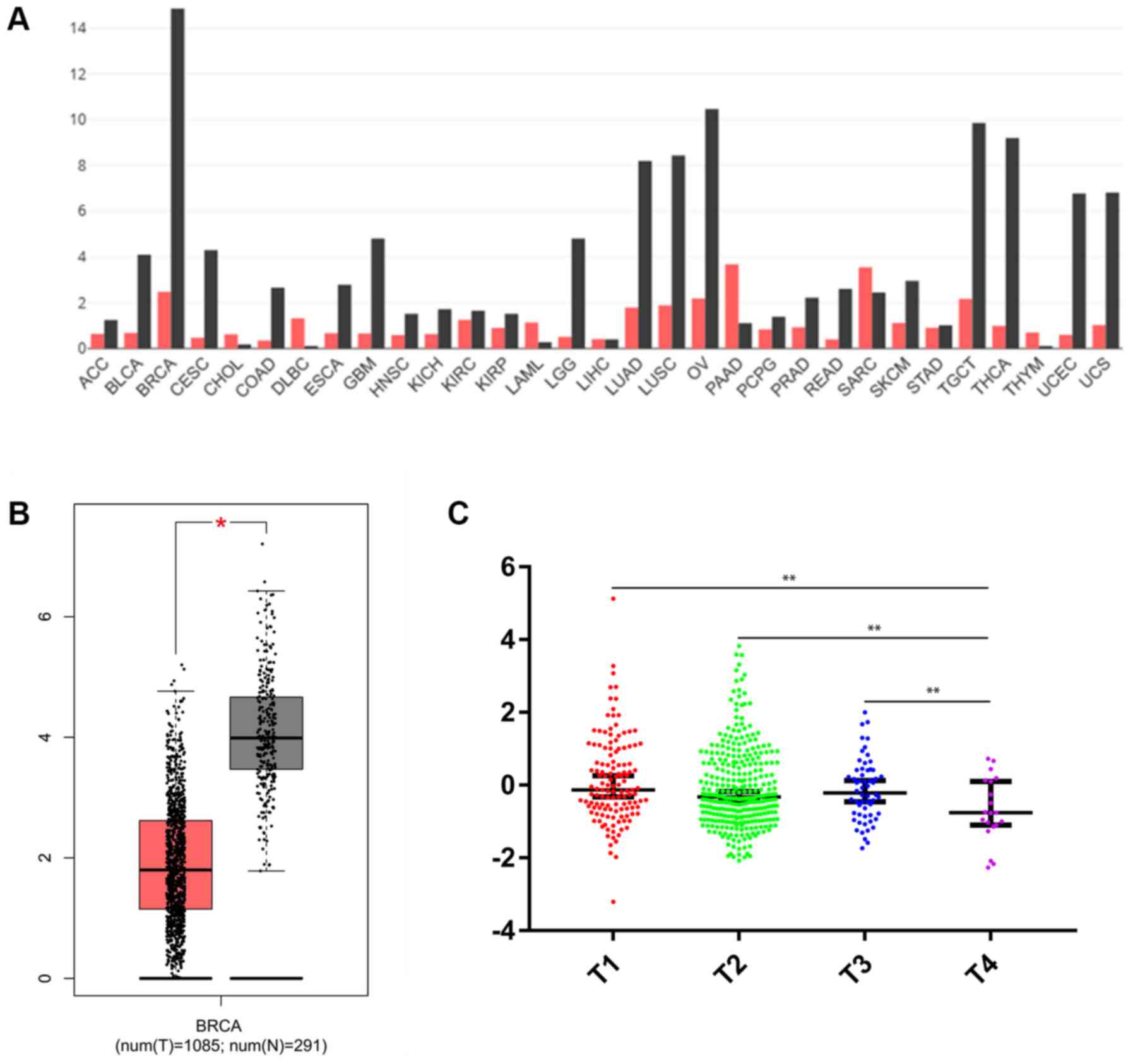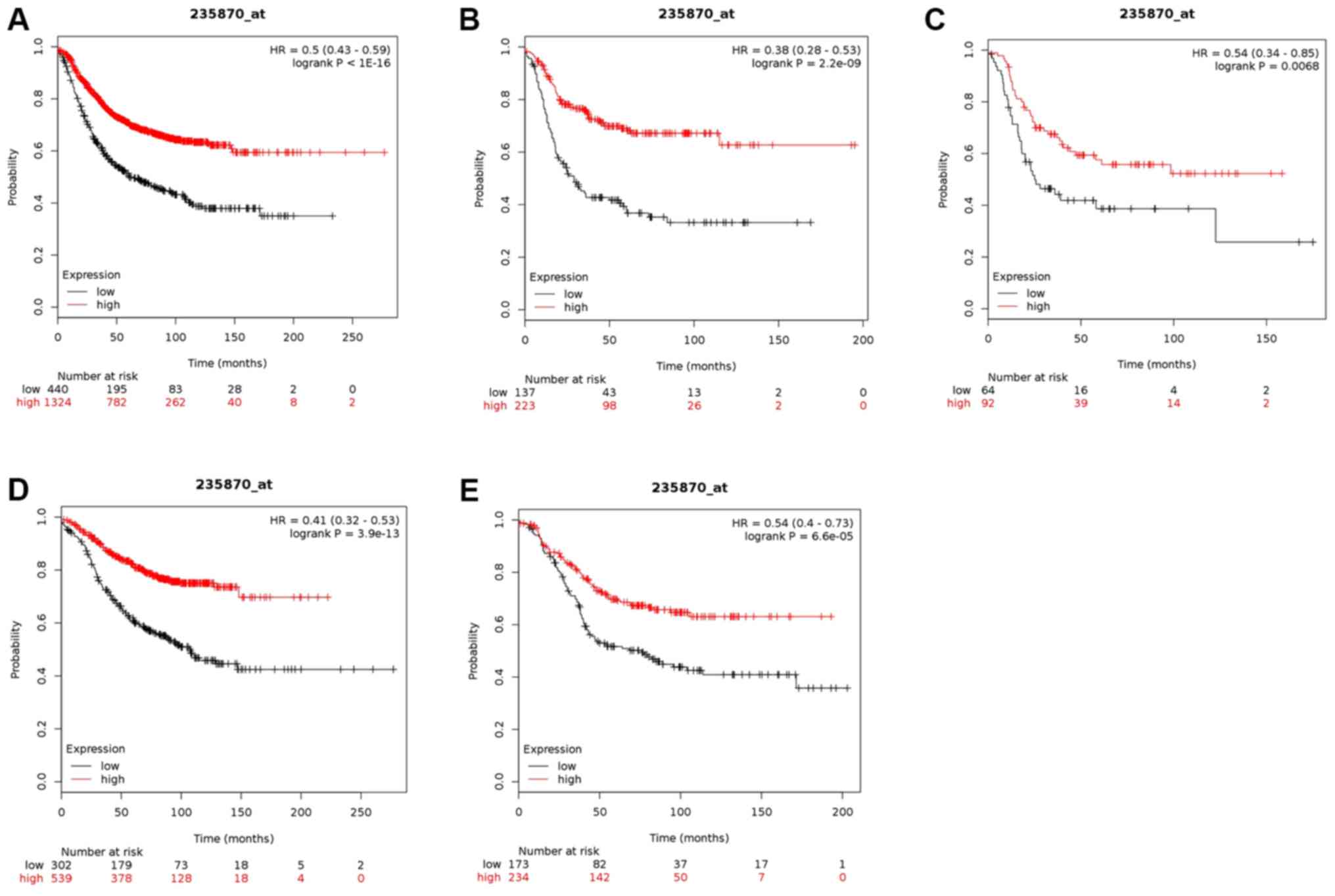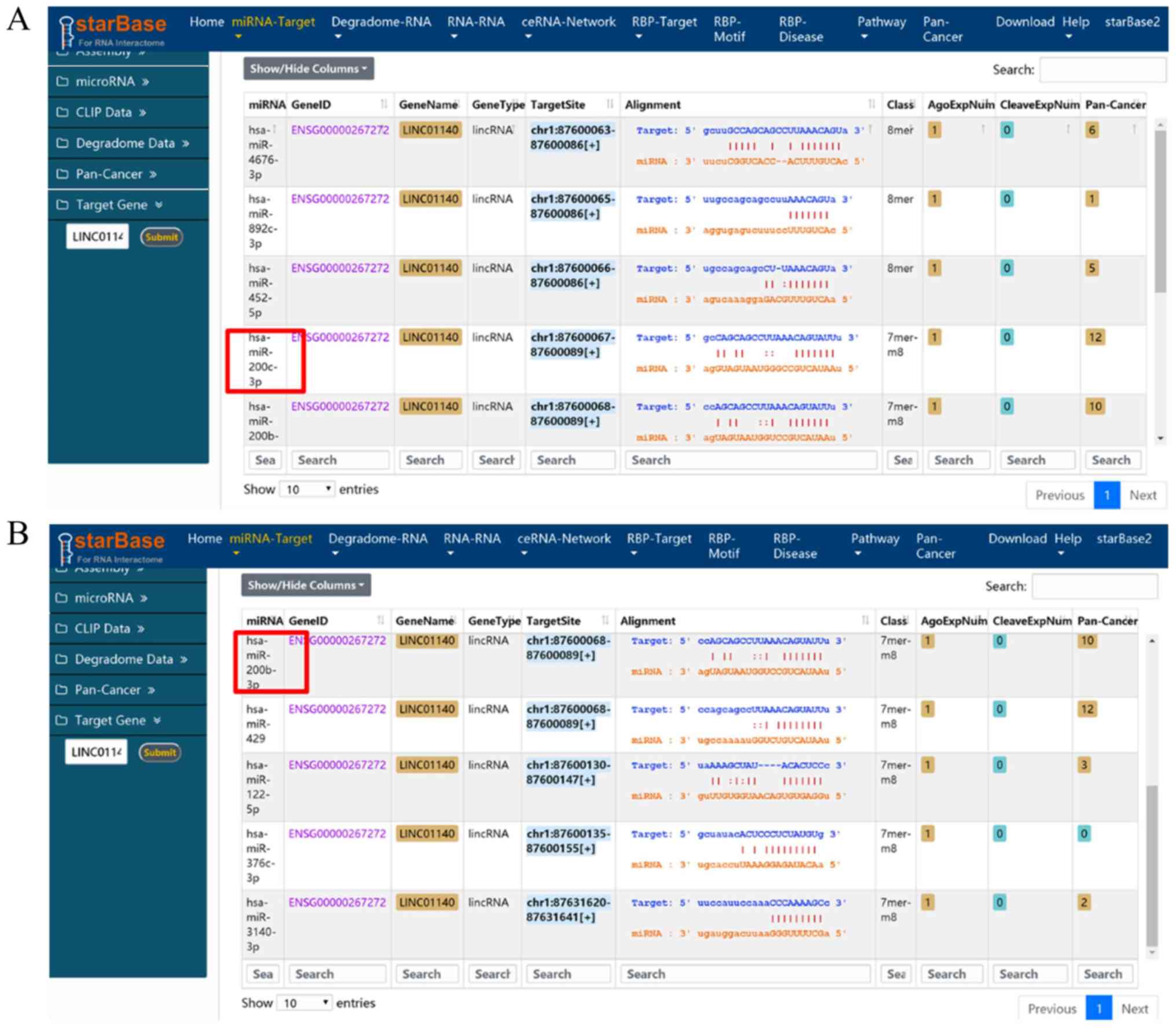Introduction
Breast cancer (BC) is one of the most common and
dangerous malignant disorders among women. There are ~1.7 million
new cases of BC every year, accounting for a quarter of all new
cancer cases in women worldwide (1).
There is also a higher rate of mortality and morbidity among
patients with BC, despite the rapid development of modern
diagnostic and therapeutic techniques (2–4).
Elucidating the molecular mechanisms underlying BC is essential for
discovering new therapeutic targets for BC. Therefore,
understanding the regulatory network underlying BC is an essential
focus point for future studies. There is an increasing amount of
evidence that long non-coding RNAs (lncRNAs) participate in the
development and progression of BC and potentially serve as markers
of diagnosis or prognosis (4,5).
LncRNAs are defined as RNA transcripts >200 bp in
length that lack open reading frames. A number of lncRNAs were
preliminary identified by whole-genome sequencing and next
generation transcriptome sequencing (6). In previous years, numerous studies have
demonstrated that lncRNAs play an important role in the biological
process of various diseases, including carcinogenesis and tumor
progression, particularly in BC, by means of regulating gene
expression at the epigenetic, transcriptional and
post-transcriptional levels (6,7).
Long intergenic non-protein coding RNA 01140
(LINC01140) is located on chromosome 1p22.3. At the site of
transcription, LINC01140, unlike proteins, could accommodate the
transcription of genome-adjacent protein-coding genes in cis and
regulate the transcription of distal protein-coding genes in trans
(8,9). The association between LINC01140
expression and survival outcome was evaluated in patients with
gastric cancer (GC). The results demonstrated that LINC01140 is
significantly associated with overall survival in patients with GC
(9). Therefore, it is valuable to
investigate the functional roles of LINC01140. To investigate the
roles and molecular mechanisms of LINC01140 in BC, LINC01140
expression was analyzed in 1,085 breast cancer patients and 291
healthy subjects using Gene Expression Profiling Interactive
Analysis (GEPIA). The association between LINC01140 expression and
T stages, LINC01140-related biological pathways, and the
correlation between certain LINC01140 expression genes were also
analyzed in 825 patients with BC via the cBioPortal database.
Materials and methods
The data on LINC01140 expression from 1,085 patients
with BC and 291 healthy tissues were collected from the web
resource of Gene Expression Profiling Interactive Analysis (GEPIA)
(10). GEPIA is a developed
interactive web server for analyzing RNA sequencing expression data
from tumors and normal samples. The present study acquired the
clinical data for the patients with BC from the open access
cBioPortal database (http://www.cbioportal.org) (11,12),
which provides web resources for analyzing multidimensional cancer
genome data, as well as graphical summaries of gene-level data from
multiple platforms and survival analyses. The present study used a
two-tailed Student's t-test to evaluate statistical discrepancies
between two groups. Survival probability was determined using a
Kaplan-Meier plotter (http://kmplot.com/analysis) (13). Patients with BC were divided into
high LINC01140 or low LINC01140 based on the median value of
LINC01140 expression. The association between LINC01140 expression
and T stages, LINC01140-related biological pathways, and the
correlation between LINC01140 expression genes were analyzed in 825
patients with BC through the cBioPortal database (14). Gene enrichment analyses were
performed using FUNRICH software (version 3.0) for the co-expressed
genes from the cBioPortal database (15). The microRNA (miRNA/miR)-LINC01140
interactions were analyzed by Ago CLIP-seq Data from starBase
(http://starbase.sysu.edu.cn) (16).
Results
LINC01140 is downregulated in BC
tissues and low LINC01140 expression is associated with a worse
prognosis in patients with BC
In multiple types of cancer, particularly in BC, the
expression of LINC01140 is downregulated (Fig. 1A and B). Compared with the mammary
tissues in BC, the expression of LINC01140 is almost 6 times higher
in normal mammary tissues. In the present study, LINC01140
expression in 1,085 patients with BC and 291 healthy subjects from
RNA sequencing datasets was analyzed through GEPIA. It was revealed
that LINC01140 expression was significantly decreased in BC tissues
compared with normal tissues (P<0.05; Fig. 1B). The impact of the LINC01140
expression on RFS probability and BC was analyzed using a
Kaplan-Meier plotter. The results revealed that in general, high
LINC01140 expression predicts longer RFS probability in all
patients with BC, including those with Basal-like, HER2-positive
and Luminal-A and Luminal-B subtypes. While, low LINC01140
expression levels were associated with shorter RFS survival
probability of patients with BC (Fig.
2), which is consistent with the fact that LINC01140 expression
was decreased in BC compared with normal tissues.
Expression of LINC01140 is associated
with T stages of patients with BC
The 825 patients with BC were divided into T1, T2,
T3 and T4 stages according to tumor size. The detailed demographic
of the patients with BC is presented in Table SI. It was revealed that LINC01140
expression was significantly decreased in T4 stage in the patients
with BC when compared with T1, T2 or T3 stages (P<0.01; Fig. 1C). Above all, it was demonstrated
that higher LINC01140 expression was beneficial for patients with
BC.
Potential biological pathways or
processes that LINC01140 may be involved in
The present study also demonstrated that LINC01140
may be involved in a series of biological pathways, such as
PAR1-mediated thrombin signaling events, endothelins, proteoglycan
syndecan-mediated signaling events, interferon-γ pathway, α9 β1
integrin signaling events, ErbB receptor signaling network,
glypican 1 network, β1 integrin cell surface interactions, integrin
family cell surface interactions, plasma membrane estrogen receptor
signaling, glypican pathway and particularly in the EMT (Fig. 3).
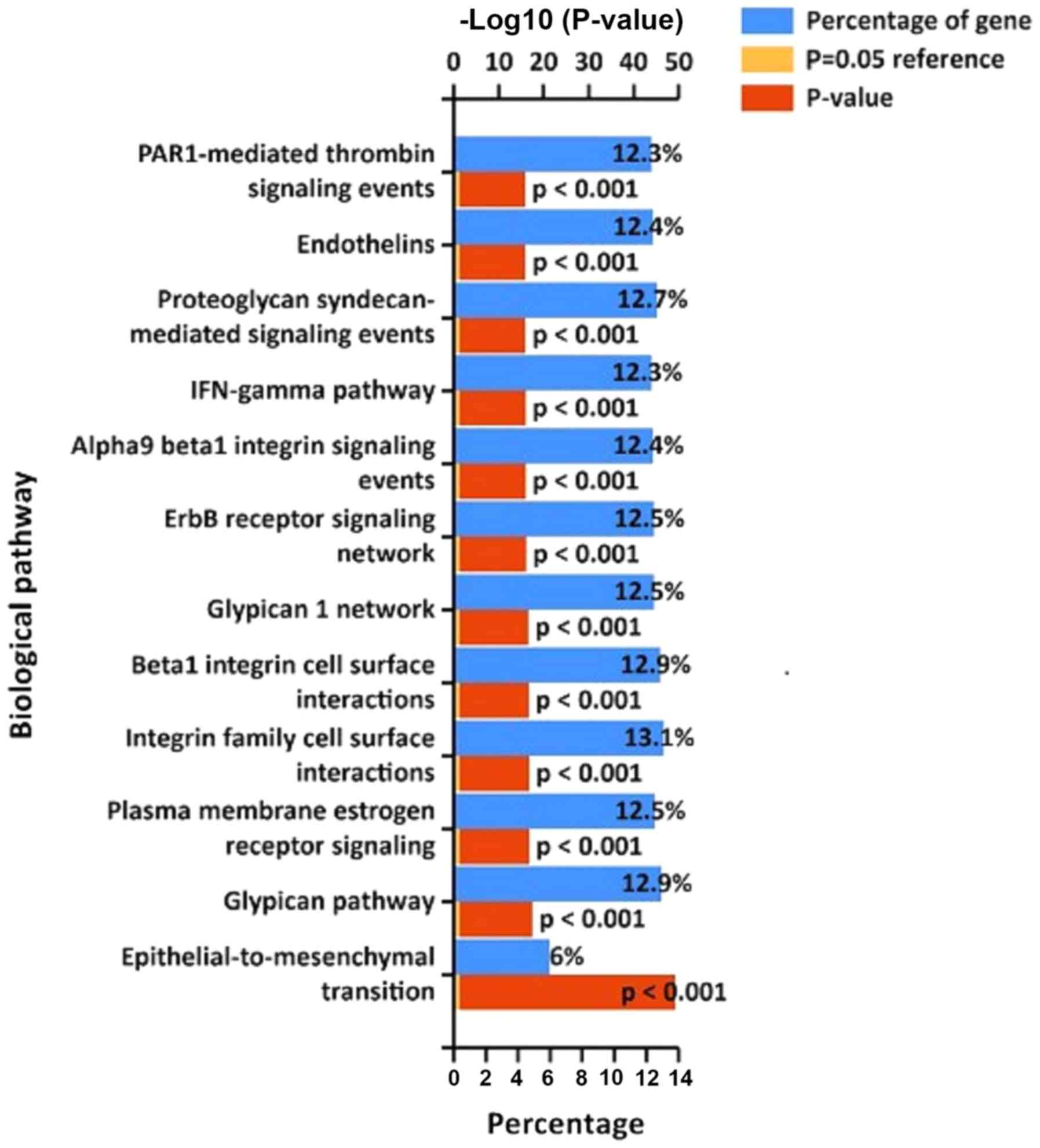 | Figure 3.LINC01140 is involved in biological
pathways. The biological pathways include PAR1-mediated thrombin
signaling events, endothelins, proteoglycan syndecan-mediated
signaling events, IFN-γ pathway, α9 β1 integrin signaling events,
ErbB receptor signaling network, glypican 1 network, β1 integrin
cell surface interactions, intergrin family cell surface
interactions, plasma membrane estrogen receptor signaling, glypican
pathway and epithelial-to-mesenchymal transition. IFN, interferon;
LINC01140, long intergenic non-protein coding RNA 01140. |
Results in Fig. 4
showed the correlation of each gene expression with LINC01140
expression, including transforming growth factor β receptor
2 (TGFBR2; Pearson r=0.58), snail family
transcriptional repressor 2 (SNAI2; Pearson r=0.37),
zinc finger E-box binding homeobox 1 (ZEB2; Pearson
r=0.53), twist family bHLH transcription factor 2
(TWIST2; Pearson r=0.52), vimentin (VIM;
Pearson r=0.52), claudin 5 (CLDN5; Pearson r=0.48),
transforming growth factor β1 (TGFB1; Pearson
r=0.31), bone morphogenic protein 6 (BMP6; Pearson
r=.53), integrin subunit α7 (ITGA7; Pearson r=0.62), SMAD
family member 9 (SMAD9; Pearson r=0.38) and chordin
like 1 (CHRDL1; Pearson r=0.77). These genes were
co-expressed with LINC01140 expression. The miRNA-LINC01140
interactions supported the Ago CLIP-seq Data. It was observed that
miR-200c and miR-200b interacted with LINC01140 (Fig. 5). The competing endogenous RNA
interaction network of LINC01140 in humans was also obtained
through Ago CLIP-seq Data. LINC01140 and PITX2 share miRNA
families, such as miR-200c and miR-200b (Table I).
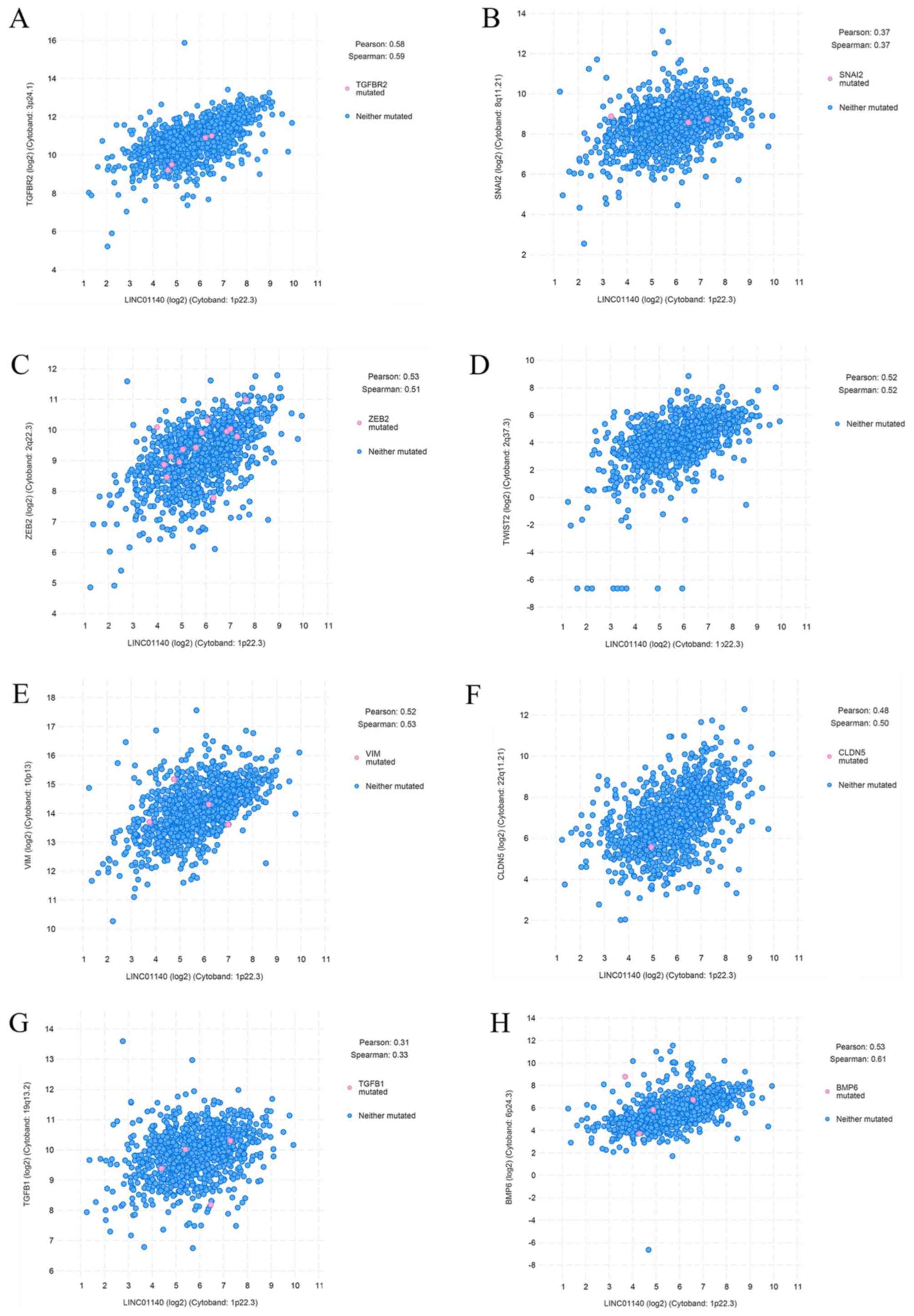 | Figure 4.Plot showing the co-expression
association between the LINC01140 and the abundance of genes in
samples from the breast cancer study. These genes were co-expressed
with LINC01140 expression. All the Pearson values are >0.30. (A)
TGFBR2, (B) SNAI2, (C) ZEB2, (D) TWIST2, (E) VIM, (F) CLDN5, (G)
TGFB1, (H) BMP6. Plot showing the co-expression association between
the LINC01140 and the abundance of genes in samples from the breast
cancer study. These genes were co-expressed with LINC01140
expression. All the Pearson values are >0.30. (I) iTGA7, (J)
SMAD9, (K) CHRDL1. LINC01140, long intergenic non-protein coding
RNA 01140; TGFBR2, transforming growth factor β receptor 2; SNAI2,
snail family transcriptional repressor 2; ZEB2, zinc finger E-box
binding homeobox 1; TWIST2, twist family bHLH transcription factor
2; VIM, vimentin; CLDN5, claudin 5; TGFB1, transforming growth
factor β1; BMP6, bone morphogenic protein 6; ITGA7, integrin
subunit α7; SMAD9, SMAD family member 9; CHRDL1, chordin like
1. |
 | Table I.The ceRNA interaction network of
LINC01140 in humans. |
Table I.
The ceRNA interaction network of
LINC01140 in humans.
| ceRNA Gene ID | ceRNA name | ceRNA type | Gene ID | Gene name | Gene type | HitMitRnum | P-value | FDR | Pan-cancer |
|---|
| ENSG00000267272 | LINC01140 | LincRNA | ENSG00000164093 |
PITX2 | Protein coding | 4 |
2.103×10−4 |
1.051×10−3 | 18 |
| ENSG00000267272 | LINC01140 | LincRNA | ENSG00000085433 | WDR47 | Protein coding | 5 |
2.801×10−4 |
1.051×10−3 | 26 |
|
ENSG00000267272 | LINC01140 | LincRNA |
ENSG00000176401 | EID28 | Protein coding | 4 |
4.767×10−4 |
1.051×10−3 | 17 |
|
ENSG00000267272 | LINC01140 | LincRNA |
ENSG00000172260 | NEGR1 | Protein coding | 5 |
5.257×10−4 |
1.051×10−3 | 21 |
|
ENSG00000267272 | LINC01140 | LincRNA |
ENSG00000164609 | SLU7 | Protein coding | 5 |
6.490×10−4 |
1.051×10−3 | 15 |
Discussion
LINC01140 is located in chromosome 1p22.3 and is
involved in regulating the transcription of genomic neighboring
protein coding genes and long distance protein-coding genes in cis
or in trans, respectively. A previous study evaluated the
association between LINC01140 expression and survival outcome in
patients with GC (9). A significant
correlation between LINC01140 and overall survival was observed in
patients with GC. Therefore, LINC01140 was combined to form a
single prognostic signature in GC.
The present study also revealed that LINC01140 is
involved in numerous different biological pathways, particularly in
the epithelial-to-mesenchymal transition (EMT). EMT is crucial for
embryogenesis as a cellular program, which plays a role in
malignant progression and wound healing. Numerous studies in humans
have demonstrated that increased tumor-initiating and metastatic
potential were promoted by EMT during neoplasia (17). EMT is controlled by a number of
transduction pathways culminating in the core and dominant
transcription factors of the process (18). Notably, the co-expression
relationship between the LINC01140 and an abundance of genes in
samples from the BC study was revealed. These genes encode the core
transcription factors that play a vital role in the EMT, such as
TGFBR2, SNAI2, ZEB2, TWIST2, VIM, CLDN5, TGFB1, BMP6, ITGA7,
SMAD9 and CHRDL1.
CHRDL1 is a bone morphogenetic protein (BMP)
inhibitor and is involved in modulating the activity of the BMP
signaling pathway. The CHRDL1 protein could competitively bind to
BMPs and antagonize their function by the means of secreting into
the extracellular space (19). BMPs
were first identified for inducing ectopic bone formation and play
an important role in morphogenesis during the development period.
They are multifunctional growth factors that belong to the
superfamily of transforming growth factor-β (TGF-β) (20). Cyr-Depauw et al (21) demonstrated that under decreased ShcA
signaling conditions, CHRDL1 expression is upregulated in a
large amount of breast cancer cells following TGF-stimulation. The
authors also observed that CHRDL1 plays a role as an inhibitor of
BMP4-induced migration and invasion by the way of in vitro
experiments. Furthermore, CHRDL1 expression is a favorable
prognostic factor for patients with BC. Another study revealed a
significant downregulation of CHRDL1 expression in GC
tissues, which was associated with a low survival rate. A close
association between low CHRDL1 expression and metastasis was
observed through the clinical and pathological parameter.
Furthermore, the authors revealed that downregulation of
CHRDL1 promoted the proliferation and migration of tumor
cells through the BMP receptor II. In addition, the authors
confirmed that CHRDL1 is a tumor suppressor gene that
inhibits tumor growth and metastasis (22).
BMP6 is closely associated with tumor
differentiation and bone metastasis (23). Hamdy et al (24) revealed that BMP6 expression in
primary malignant cancer was closely associated with bone
metastasis. The result implied that BMP6 may be partly responsible
for osteoblastic changes in prostate cancer secondary metastases.
Taking previous studies into consideration, it can be confirmed
that patients with ER+ BC are more likely to develop bone
metastasis. These results confirmed that BMP6 plays a vital role in
the development of ER+ BC bone metastasis (23–25).
Further analyses observed that miR-200b and miR-200c
interacted with LINC01140. The miR-200 family consists of five
members in humans. One cluster comprised of miR-200b, miR-200a and
miR-429 on the chromosome one, while another cluster included two
members, miR-200c and miR-141, which were located on chromosome 12.
During tumorigenesis and development, the miR-200 family could
regulate cell viability, cell division, cell cycle progression,
differentiation, apoptosis, self-renewal, reversal of chemotherapy
resistance and EMT (26). Abnormal
expression of the miR-200 family is associated with the occurrence
and development of BC (27,28). A study by Yang et al (29) demonstrated that the miR200 family is
actively associated with the EMT through targeting and inhibiting
the expression of genes, such as ZEB1, ZEB2, β-catenin/Wnt
signaling, while a number of transcription factors, including
Snail, Slug, ZEB-1, ZEB-2 and Twist1, are associated with tumor
invasion and metastasis. Therefore, LINC01140 may interact with
miR-200 according to the prediction results of the database.
In conclusion, LINC01140 expression was observed to
be lower in individuals with BC. In general, its expression was
associated with the probability of RFS. High LINC01140 predicts
longer RFS probability of patients with BC. LINC01140 plays an
important role in the development and progression of BC. Further
studies are required in order to elucidate the underlying molecular
mechanisms. The present study provides the foundations for
investigating the underlying molecular mechanism of LINC01140 in
the development and progression of BC.
Supplementary Material
Supporting Data
Acknowledgements
Not applicable.
Funding
The present study was supported by the National
Nature Science Foundation of China (grant nos. 81572921 and
81802494).
Availability of data and materials
The datasets used and/or analyzed during the present
study are available from the corresponding author upon reasonable
request.
Authors' contributions
YC and XC participated in the conception and design
of the study. DL and LL analyzed and interpreted the data. DL and
LL drafted the manuscript, and YC and XC edited it critically. All
authors gave final approval of the version to be published.
Ethics approval and consent to
participate
Not applicable.
Patient consent for publication
Not applicable.
Competing interests
The authors declare that they have no competing
interests.
References
|
1
|
Torre LA, Bray F, Siegel RL, Ferlay J,
Lortet-Tieulent J and Jemal A: Global cancer statistics, 2012. CA
Cancer J Clin. 65:87–108. 2015. View Article : Google Scholar : PubMed/NCBI
|
|
2
|
Fan LM, Strasser-Weippl KM, Li JM, St
Louis JB, Finkelstein DMP, Yu KM, Chen WM, Shao ZM and Goss PEP:
Breast cancer in China. Lancet Oncol. 15:e279–e289. 2014.
View Article : Google Scholar : PubMed/NCBI
|
|
3
|
Akram M, Iqbal M, Daniyal M and Khan AU:
Awareness and current knowledge of breast cancer. Biol Res.
50:332017. View Article : Google Scholar : PubMed/NCBI
|
|
4
|
Hu X, Liu Y, Du Y, Cheng T and Xia W: Long
non-coding RNA BLACAT1 promotes breast cancer cell proliferation
and metastasis by miR-150-5p/CCR2. Cell Biosci. 9:142019.
View Article : Google Scholar : PubMed/NCBI
|
|
5
|
Jiang Y, Du F, Chen F, Qin N, Jiang Z,
Zhou J, Jiang T, Pu Z, Cheng Y, Chen J, et al: Potentially
functional variants in lncRNAs are associated with breast cancer
risk in a Chinese population. Mol Carcinogen. 56:2048–2057. 2017.
View Article : Google Scholar
|
|
6
|
Liu Y, Sharma S and Watabe K: Roles of
lncRNA in breast cancer. Front Biosci (Schol Ed). 7:94–108. 2015.
View Article : Google Scholar : PubMed/NCBI
|
|
7
|
Niknafs YS, Han S, Ma T, Speers C, Zhang
C, Wilder-Romans K, Iyer MK, Pitchiaya S, Malik R, Hosono Y, et al:
The lncRNA landscape of breast cancer reveals a role for DSCAM-AS1
in breast cancer progression. Nat Commun. 7:127912016. View Article : Google Scholar : PubMed/NCBI
|
|
8
|
Batista PJ and Chang HY: Long noncoding
RNAs: Cellular address codes in development and disease. Cell.
152:1298–1307. 2013. View Article : Google Scholar : PubMed/NCBI
|
|
9
|
Song P, Jiang B, Liu Z, Ding J, Liu S and
Guan W: A three-lncRNA expression signature associated with the
prognosis of gastric cancer patients. Cancer Med. 6:1154–1164.
2017. View Article : Google Scholar : PubMed/NCBI
|
|
10
|
Li J, Han L, Roebuck P, Diao L, Liu L,
Yuan Y, Weinstein JN and Liang H: TANRIC: An interactive open
platform to explore the function of lncRNAs in cancer. Cancer Res.
75:3728–3737. 2015. View Article : Google Scholar : PubMed/NCBI
|
|
11
|
Cerami E, Gao J, Dogrusoz U, Gross BE,
Sumer SO, Aksoy BA, Jacobsen A, Byrne CJ, Heuer ML, Larsson E, et
al: The cBio cancer genomics portal: An open platform for exploring
multidimensional cancer genomics data. Cancer Discov. 2:401–404.
2012. View Article : Google Scholar : PubMed/NCBI
|
|
12
|
Gao J, Aksoy BA, Dogrusoz U, Dresdner G,
Gross B, Sumer SO, Sun Y, Jacobsen A, Sinha R, Larsson E, et al:
Integrative analysis of complex cancer genomics and clinical
profiles using the cBioPortal. Sci Signal. 6:pl12013. View Article : Google Scholar : PubMed/NCBI
|
|
13
|
Nagy Á, Lánczky A, Menyhárt O and Győrffy
B: Validation of miRNA prognostic power in hepatocellular carcinoma
using expression data of independent datasets. Sci Rep. 8:92272018.
View Article : Google Scholar : PubMed/NCBI
|
|
14
|
Cancer Genome Atlas Network: Comprehensive
molecular portraits of human breast tumours. Nature. 490:61–70.
2012. View Article : Google Scholar : PubMed/NCBI
|
|
15
|
Pathan M, Keerthikumar S, Ang C, Gangoda
L, Quek CYJ, Williamson NA, Mouradov D, Sieber OM, Simpson RJ,
Salim A, et al: FunRich: An open access standalone functional
enrichment and interaction network analysis tool. Proteomics.
15:2597–2601. 2015. View Article : Google Scholar : PubMed/NCBI
|
|
16
|
Li JH, Liu S, Zhou H, Qu LH and Yang JH:
starBase v2.0: Decoding miRNA-ceRNA, miRNA-ncRNA and protein-RNA
interaction networks from large-scale CLIP-Seq data. Nucleic Acids
Res. 42((Database Issue)): D92–D97. 2014. View Article : Google Scholar : PubMed/NCBI
|
|
17
|
Dongre A and Weinberg RA: New insights
into the mechanisms of epithelial-mesenchymal transition and
implications for cancer. Nat Rev Mol Cell Biol. 20:69–84. 2019.
View Article : Google Scholar : PubMed/NCBI
|
|
18
|
Voutsadakis I: Epithelial-Mesenchymal
Transition (EMT) and regulation of EMT factors by steroid nuclear
receptors in breast cancer: A review and in silico
investigation. J Clin Med. 5(pii): E112016. View Article : Google Scholar : PubMed/NCBI
|
|
19
|
Balemans W and Van Hul W: Extracellular
regulation of BMP signaling in vertebrates: A cocktail of
modulators. Dev Biol. 250:231–250. 2002. View Article : Google Scholar : PubMed/NCBI
|
|
20
|
Attisano L and Wrana JL: Signal
transduction by members of the transforming growth factor-beta
superfamily. Cytokine Growth Factor Rev. 7:327–339. 1996.
View Article : Google Scholar : PubMed/NCBI
|
|
21
|
Cyr-Depauw C, Northey JJ, Tabariès S,
Annis MG, Dong Z, Cory S, Hallett M, Rennhack JP, Andrechek ER and
Siegel PM: Chordin-like 1 suppresses bone morphogenetic protein
4-induced breast cancer cell migration and invasion. Mol Cell Biol.
36:1509–1525. 2016. View Article : Google Scholar : PubMed/NCBI
|
|
22
|
Pei YF, Zhang YJ, Lei Y, Wu DW, Ma TH and
Liu XQ: Hypermethylation of the CHRDL1 promoter induces
proliferation and metastasis by activating Akt and Erk in gastric
cancer. Oncotarget. 8:23155–23166. 2017. View Article : Google Scholar : PubMed/NCBI
|
|
23
|
Zhang M, Wang Q, Yuan W, Yang S, Wang X,
Yan J, Du J, Yin J, Gao SY, Sun BC and Zhu TH: Epigenetic
regulation of bone morphogenetic protein-6 gene expression in
breast cancer cells. J Steroid Biochem Mol Biol. 105:91–97. 2007.
View Article : Google Scholar : PubMed/NCBI
|
|
24
|
Hamdy FC, Autzen P, Robinson MC, Horne CH,
Neal DE and Robson CN: Immunolocalization and messenger RNA
expression of bone morphogenetic protein-6 in human benign and
malignant prostatic tissue. Cancer Res. 57:4427–4431.
1997.PubMed/NCBI
|
|
25
|
Maki DD and Grossman RI: Patterns of
disease spread in metastatic breast carcinoma: Influence of
estrogen and progesterone receptor status. Am J Neuroradiol.
21:1064–1066. 2000.PubMed/NCBI
|
|
26
|
Mekala JR, Naushad SM, Ponnusamy L,
Arivazhagan G, Sakthiprasad V and Pal-Bhadra M: Epigenetic
regulation of miR-200 as the potential strategy for the therapy
against triple-negative breast cancer. Gene. 641:248–258. 2018.
View Article : Google Scholar : PubMed/NCBI
|
|
27
|
Ning X, Shi Z, Liu X, Zhang A, Han L,
Jiang K, Kang C and Zhang Q: DNMT1 and EZH2 mediated methylation
silences the microRNA-200b/a/429 gene and promotes tumor
progression. Cancer Lett. 359:198–205. 2015. View Article : Google Scholar : PubMed/NCBI
|
|
28
|
Zhang G, Zhang W, Li B, Stringer-Reasor E,
Chu C, Sun L, Bae S, Chen D, Wei S, Jiao K, et al: MicroRNA-200c
and microRNA-141 are regulated by a FOXP3-KAT2B axis and associated
with tumor metastasis in breast cancer. Breast Cancer Res.
19:732017. View Article : Google Scholar : PubMed/NCBI
|
|
29
|
Yang J and Weinberg RA:
Epithelial-mesenchymal transition: At the crossroads of development
and tumor metastasis. Dev Cell. 14:818–829. 2008. View Article : Google Scholar : PubMed/NCBI
|















